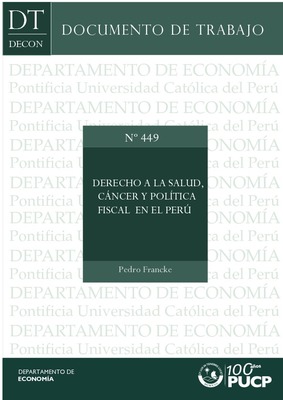| dc.description.abstract | El Perú registra grandes desigualdades sociales y un bajo gasto público en salud. Ha avanzado en enfermedades trasmisibles y salud materno-infantil, pero las no trasmisibles hoy constituyen tres quintas partes de la carga de enfermedad y hay 45 mil nuevos casos de cáncer al año. La baja inversión social y centralización de la atención del cáncer discriminan contra los indígenas. Un tercio de limeñas ha hecho mamografía en los últimos 2 años pero apenas 4% en zonas rurales. La cobertura del Papanicolaou, un examen preventivo básico, llega solo a 50% en sierra y selva. En Lima se concentran casi tres de cada cuatro de los especialistas y hay un alto costo del tratamiento. Habiendo gozado el Perú del boom de las materias primas, el Estado ha actuado de manera tardía e insuficiente ante el cáncer. Recién a partir de 2012, luego de 8 años de auge fiscal, se estableció un programa público de prevención y control. El cáncer da cuenta del 18% de las muertes en el Perú, pero menos del 6% presupuesto en salud, apenas 0,12% del PBI. Mientras entre 2008 y 2012 la recaudación tributaria aumentó de USD 13 mil a 26 mil millones anuales, en 2012 el programa contra el cáncer solo recibía 130 millones anuales. Desde el 2014 la recaudación tributaria ha caído y el gobierno ha frenado el gasto en salud y en especial en cáncer, que ha registrado reducciones presupuestales el 2016 y 2017.
Peru is a country of great social inequalities and low public expenditure in health. There have been advances in communicable diseases and maternal and infant health, but non-communicable diseases constitute 60 per cent of the burden of disease and there are 45 000 new cancer cases per year. Low social investment and a centralized system of cancer care discriminate against indigenous people. One third of women en Lima have had a mammography in the last two years but only 4 per cent in total areas. Papanicolau, a basic preventive exam for cervix cancer, covers only 50% of women in the Andean and jungle regions. Lima concentrates three of every four cancer specialists and the costs of treatment are high. Having Peru benefit from the commodities prices boom in the last decade, the policy against cancer has been slow and insufficient. Only from 2012, after eight years of fiscal plenty, a public program against cancer was established. Cancer accounts for 18% of all deaths in Peru but less than 6%of the national health budget, equivalent to only 0,12% of GDP. Between 2008 and 2012 fiscal revenues increased from USD 13,000 to 26,000 million, however, in 2012 the budget for cancer was only USD 130 million. Since 2014 fiscal revenues have gone down and the government has reduced the budget for cancer in 2016 and 2017. | en_US |


